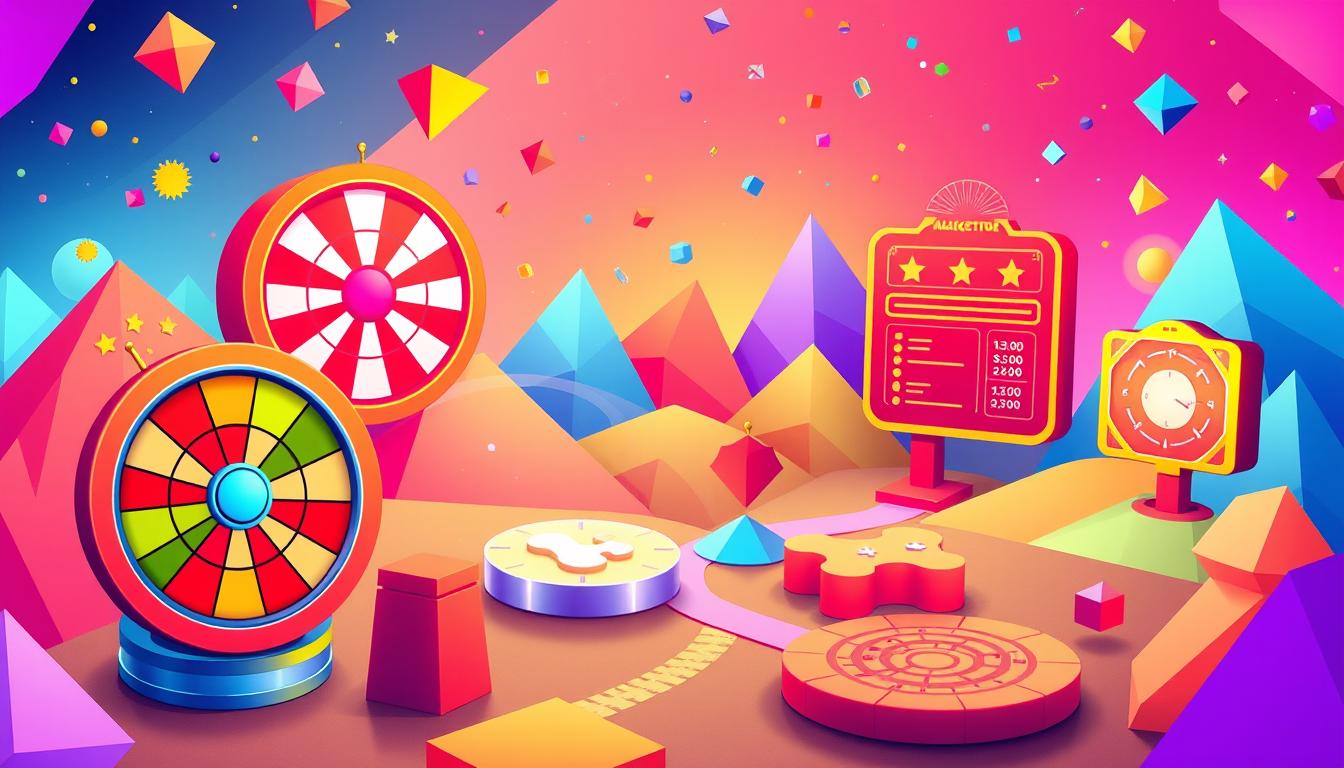Welcome to the exciting world of lead generation 101! In today’s digital landscape, capturing attention is key. That’s where gamification comes in, offering a fresh approach to interactive marketing. By using games to capture attention, businesses are finding innovative ways to engage potential customers and boost their lead generation efforts.
Gamification transforms the traditional lead capture process into an enjoyable experience. It taps into our natural desire for fun and competition, making the act of sharing information feel less like a chore and more like an engaging activity. This approach not only increases participation but also enhances the quality of leads generated.
Key Takeaways
- Gamification boosts engagement in lead generation efforts
- Interactive marketing techniques capture attention effectively
- Games create a fun, memorable experience for potential leads
- Lead generation 101 now includes game-based strategies
- Using games can improve both lead quantity and quality
- Gamified approaches tap into natural human motivations
Understanding the Power of Gamification in Lead Generation
Gamification taps into human psychology, making it a powerful tool for lead generation. By leveraging marketing psychology and attention-grabbing tactics, businesses can boost audience engagement and capture valuable leads.
The Psychology Behind Game-Based Engagement
Games trigger our brain’s reward system, releasing dopamine and creating a sense of achievement. This psychological response keeps users coming back for more, making gamification an effective strategy for lead generation.
Why Games Create Stronger Emotional Connections
Interactive experiences foster emotional bonds between users and brands. By providing engaging content through games, companies can create lasting impressions that drive lead conversion.
Key Benefits of Interactive Marketing Approaches
Interactive marketing offers numerous advantages for lead generation:
- Increased engagement time
- Higher conversion rates
- Improved brand recall
- Enhanced data collection
| Benefit | Traditional Marketing | Interactive Marketing |
|---|---|---|
| User Engagement | Passive | Active |
| Data Collection | Limited | Comprehensive |
| Brand Recall | Moderate | High |
| Lead Quality | Variable | Typically Higher |
By incorporating games into marketing strategies, businesses can leverage these benefits to generate high-quality leads and drive growth.
Lead Generation 101: Using Games to Capture Attention
Games have become a powerful tool in the world of lead generation. By leveraging digital games, businesses can create attention-grabbing tactics that entice potential customers. Let’s explore how to use games effectively for lead capture strategies.
Interactive experiences are key to capturing audience attention. By incorporating game elements into your marketing, you can:
- Boost engagement rates
- Increase time spent on your website
- Collect valuable customer data
- Create memorable brand experiences
One effective approach is to use quizzes or puzzles related to your product or service. These games can provide value to the user while subtly introducing your offerings. For example, a financial advisor might create a quiz about SBA loans to attract potential clients.
“Games are the new frontier in lead generation, offering an unparalleled opportunity to engage and convert.”
Here’s a comparison of traditional lead capture methods versus game-based strategies:
| Aspect | Traditional Methods | Game-Based Strategies |
|---|---|---|
| User Engagement | Passive | Active and interactive |
| Data Collection | Limited | Comprehensive |
| Brand Recall | Low to moderate | High |
| Lead Quality | Variable | Generally higher |
By implementing these game-based lead capture strategies, you can create a more engaging and effective lead generation process. Remember to keep your games simple, relevant, and rewarding to maximize their impact on your marketing efforts.
Types of Games That Drive Lead Generation Success
Game-based lead generation has revolutionized marketing strategies, offering engaging ways to capture audience attention. Let’s explore the most effective game types for boosting your interactive marketing efforts.
Quiz-Based Lead Capture Games
Quizzes are powerful tools in branded games. They challenge users’ knowledge while collecting valuable data. A well-crafted quiz can boost engagement and foster trust, much like personalized financial advice.
Interactive Puzzles and Challenges
Puzzles stimulate problem-solving skills, keeping users invested in your content. These games can showcase your brand’s creativity while gathering leads subtly.
Reward-Based Gaming Systems
Offering incentives through games taps into users’ competitive nature. Points, badges, or real-world prizes can significantly increase participation and lead quality.
Virtual Scavenger Hunts
Digital scavenger hunts create an exciting journey for users. They explore your brand while providing contact information at various checkpoints.
| Game Type | Engagement Level | Lead Quality | Implementation Difficulty |
|---|---|---|---|
| Quiz-Based Games | High | Medium | Low |
| Interactive Puzzles | Medium | High | Medium |
| Reward-Based Systems | Very High | High | High |
| Virtual Scavenger Hunts | High | Very High | Medium |
By incorporating these game types into your marketing strategy, you can create a dynamic and effective lead generation funnel. Remember, the key is to align the game with your brand and audience preferences for maximum impact.
Implementing Game Mechanics in Your Marketing Strategy

Gamification has revolutionized lead capture strategies. By integrating game mechanics into your marketing approach, you can boost engagement and drive conversions. Let’s explore how to implement these interactive elements effectively.
Start by identifying your target audience’s preferences. This helps tailor your gamified content to their interests. Next, define clear objectives for your interactive marketing campaign. Whether it’s increasing email sign-ups or promoting a new product, having specific goals guides your game design.
Choose game mechanics that align with your brand and campaign goals. Some popular options include:
- Point systems
- Leaderboards
- Challenges and quests
- Progress bars
- Virtual rewards
Incorporate these elements into your existing marketing channels. For example, add a quiz to your website or create a loyalty program for social media followers. This integration enhances user experience and encourages participation.
Remember to keep your games simple and intuitive. Overly complex mechanics can deter users. Focus on creating an enjoyable experience that naturally leads to lead generation.
“Gamification isn’t about turning everything into a game. It’s about using game design elements to motivate and engage users.”
Lastly, test and refine your gamified strategies. Monitor key metrics like engagement rates and conversion numbers. Use this data to optimize your approach and maximize results.
| Game Mechanic | Best For | Engagement Level |
|---|---|---|
| Quizzes | Lead Generation | High |
| Leaderboards | Customer Retention | Medium |
| Progress Bars | Onboarding | Low |
| Virtual Rewards | Brand Loyalty | High |
Measuring Success: Key Metrics for Game-Based Lead Generation
Game-based lead generation has revolutionized marketing psychology, making it crucial to track its effectiveness. By measuring key metrics, businesses can refine their strategies and boost ROI. Let’s explore the essential metrics for evaluating game-based lead generation campaigns.
Conversion Rate Analysis
Conversion rates indicate how well your game engages and converts players into leads. Track the percentage of users who complete desired actions, such as signing up or making a purchase. A high conversion rate suggests your game effectively captures attention and motivates action.
Engagement Time Tracking
The time users spend interacting with your game is a vital indicator of its appeal. Longer engagement times often correlate with higher lead quality. Monitor average session duration and frequency of play to gauge user interest and identify areas for improvement.
Lead Quality Assessment
Not all leads are created equal. Evaluate lead quality by tracking metrics like email open rates, response rates, and eventual conversions. High-quality leads are more likely to become customers, making them valuable assets in your lead generation 101 strategy.
ROI Calculation Methods
Calculating return on investment helps determine the overall success of your game-based lead generation efforts. Consider factors such as development costs, marketing expenses, and revenue generated from converted leads. Use this data to refine your approach and maximize profitability.
| Metric | Description | Target Range |
|---|---|---|
| Conversion Rate | Percentage of players who become leads | 2-5% |
| Engagement Time | Average time spent playing the game | 3-5 minutes |
| Lead Quality Score | Rating based on lead behavior and attributes | 7-10 out of 10 |
| ROI | Return on investment for the campaign | 200-300% |
Creating Branded Games That Convert
Branded games are powerful tools for using games to capture attention and drive lead generation. These interactive marketing experiences blend entertainment with business objectives, creating memorable interactions that resonate with potential customers.
When designing a branded game, focus on aligning game mechanics with your brand identity. This ensures a cohesive experience that reinforces your message while engaging players. Consider incorporating challenges that reflect your product features or industry knowledge to educate players subtly.
To maximize conversions, integrate lead capture elements seamlessly into the gameplay. This could include requesting contact information to save progress or enter a leaderboard. Offering valuable rewards like exclusive content or discounts can incentivize players to share their details.
“A well-designed branded game can increase engagement by 100% and boost lead quality significantly.”
Here’s a breakdown of key elements for creating effective branded games:
| Element | Purpose | Example |
|---|---|---|
| Brand-aligned visuals | Reinforce brand identity | Company colors and logo integration |
| Engaging mechanics | Keep players interested | Puzzle-solving or time-based challenges |
| Educational content | Inform about products/services | Trivia questions about industry topics |
| Lead capture points | Collect user information | Email sign-up for score saving |
By carefully crafting these elements, you can create branded games that not only entertain but also drive meaningful conversions for your business.
Integration Strategies for Gaming Elements in Marketing Campaigns
Gamification and interactive marketing are powerful tools for lead capture strategies. By integrating gaming elements into various marketing channels, businesses can create engaging experiences that boost lead generation.
Social Media Integration
Social platforms offer ideal spaces for gamified content. Create interactive quizzes, polls, or challenges that encourage users to participate and share results. This approach increases brand visibility and captures leads through fun, shareable content.
Email Marketing Connection Points
Incorporate game-like elements in email campaigns to drive engagement. Use countdown timers, scratch-off reveals, or point systems to incentivize opens and clicks. These tactics can significantly improve email performance and lead quality.
Website Implementation Techniques
Transform your website into an interactive experience. Implement progress bars for form completion, reward systems for content engagement, or virtual tours with hidden collectibles. These lead capture strategies make site exploration more enjoyable and increase conversion rates.
| Channel | Gamification Element | Expected Outcome |
|---|---|---|
| Social Media | Interactive Quizzes | Increased Shares and Lead Generation |
| Point Systems | Higher Open Rates and Click-throughs | |
| Website | Progress Bars | Improved Form Completion Rates |
By seamlessly integrating these gamified elements across marketing channels, businesses can create a cohesive and engaging experience that effectively captures and nurtures leads.
Common Pitfalls to Avoid in Game-Based Lead Generation
Game-based lead generation can be a powerful tool for capturing attention and engaging potential customers. However, there are several common mistakes that marketers should be aware of to maximize their success.

Overcomplication of Game Mechanics
One of the biggest pitfalls in game-based lead generation is creating overly complex games. While it’s tempting to design intricate challenges, simpler games often yield better results. Focus on attention-grabbing tactics that are easy to understand and play.
Poor Mobile Optimization
In today’s mobile-first world, failing to optimize your games for smartphones can severely limit your reach. Ensure your lead capture strategies work seamlessly across all devices to maximize engagement and conversion rates.
Inadequate Data Collection Methods
Effective game-based lead generation relies on gathering valuable information. Many marketers make the mistake of collecting too little data or asking for irrelevant information. Strike a balance between obtaining useful insights and respecting user privacy.
| Pitfall | Impact | Solution |
|---|---|---|
| Complex Game Mechanics | Lower engagement rates | Simplify gameplay |
| Poor Mobile Optimization | Reduced mobile conversions | Responsive design |
| Inadequate Data Collection | Low-quality leads | Strategic data gathering |
By avoiding these common pitfalls, you can create more effective game-based lead generation campaigns that drive results. Remember to keep your games simple, mobile-friendly, and focused on collecting relevant data to improve your lead capture strategies.
Case Studies: Successful Game-Based Lead Generation Campaigns
Game-based lead generation has revolutionized interactive marketing. Let’s explore real-world examples of companies that have mastered this approach.
Nike’s “Run This Town” campaign stands out as a prime example of branded games done right. The sportswear giant created a virtual running game that challenged users to explore their cities while collecting points. This innovative approach not only increased brand engagement but also captured valuable lead data from fitness enthusiasts.
Another success story comes from Domino’s Pizza. Their “Pizza Maker” game allowed customers to create virtual pizzas, learning about ingredients while having fun. The game led to a 30% boost in online orders and significantly expanded their customer database.
Coca-Cola’s “Happiness Island” campaign took interactive marketing to new heights. Players built their virtual islands, completing tasks to unlock Coca-Cola themed items. This engaging concept resulted in over 4 million game sessions and a wealth of consumer insights.
| Company | Game | Results |
|---|---|---|
| Nike | Run This Town | Increased brand engagement, valuable lead data |
| Domino’s | Pizza Maker | 30% boost in online orders, expanded customer database |
| Coca-Cola | Happiness Island | 4 million game sessions, rich consumer insights |
These case studies highlight the power of branded games in lead generation. By creating engaging, interactive experiences, companies can capture attention, gather data, and drive conversions in ways traditional marketing simply can’t match.
Future Trends in Game-Based Lead Generation
The world of gamification and digital games is evolving rapidly, bringing exciting new possibilities for interactive marketing. As technology advances, we’re seeing groundbreaking trends emerge in game-based lead generation.
Artificial intelligence is set to revolutionize how we create and personalize games for lead capture. AI-powered games can adapt in real-time to player behavior, offering tailored challenges that keep users engaged longer. This level of customization could significantly boost conversion rates and lead quality.
Virtual reality is another frontier in game-based marketing. Imagine potential customers exploring your product in a fully immersive 3D environment. VR games can create memorable brand experiences that traditional methods simply can’t match.
Personalization is becoming increasingly sophisticated. Future games might use data from social media profiles or browsing history to create uniquely relevant experiences for each player. This hyper-targeted approach could dramatically increase the effectiveness of lead generation efforts.
- AI-driven adaptive gameplay
- Immersive VR marketing experiences
- Hyper-personalized gaming elements
As these technologies mature, we can expect to see a new era of game-based lead generation. Marketers who embrace these innovations will likely find themselves at the forefront of interactive marketing, capturing high-quality leads through engaging and memorable gameplay experiences.
Conclusion
Game-based strategies have revolutionized lead generation efforts, offering a fresh approach to capturing attention and engaging potential customers. By incorporating gamification elements, businesses can create memorable experiences that resonate with their target audience. Lead generation 101 has evolved, and using games to capture attention is now a powerful tool in the marketer’s arsenal.
Throughout this guide, we’ve explored various aspects of game-based lead generation, from understanding the psychology behind engagement to implementing effective game mechanics. We’ve seen how interactive puzzles, reward systems, and virtual scavenger hunts can drive success in lead capture. The key lies in striking the right balance between fun and functionality.
As the digital landscape continues to evolve, gamification in lead generation will play an increasingly vital role. By embracing these innovative techniques, businesses can stay ahead of the curve and create meaningful connections with their audience. It’s time to level up your marketing strategy and harness the power of games to transform your lead generation efforts.






